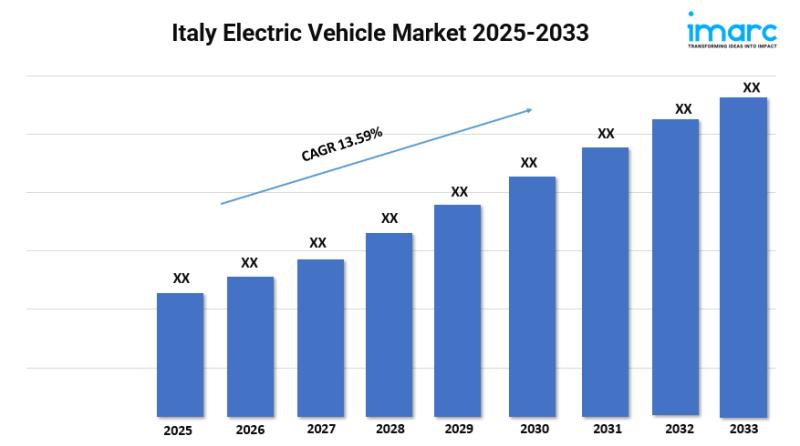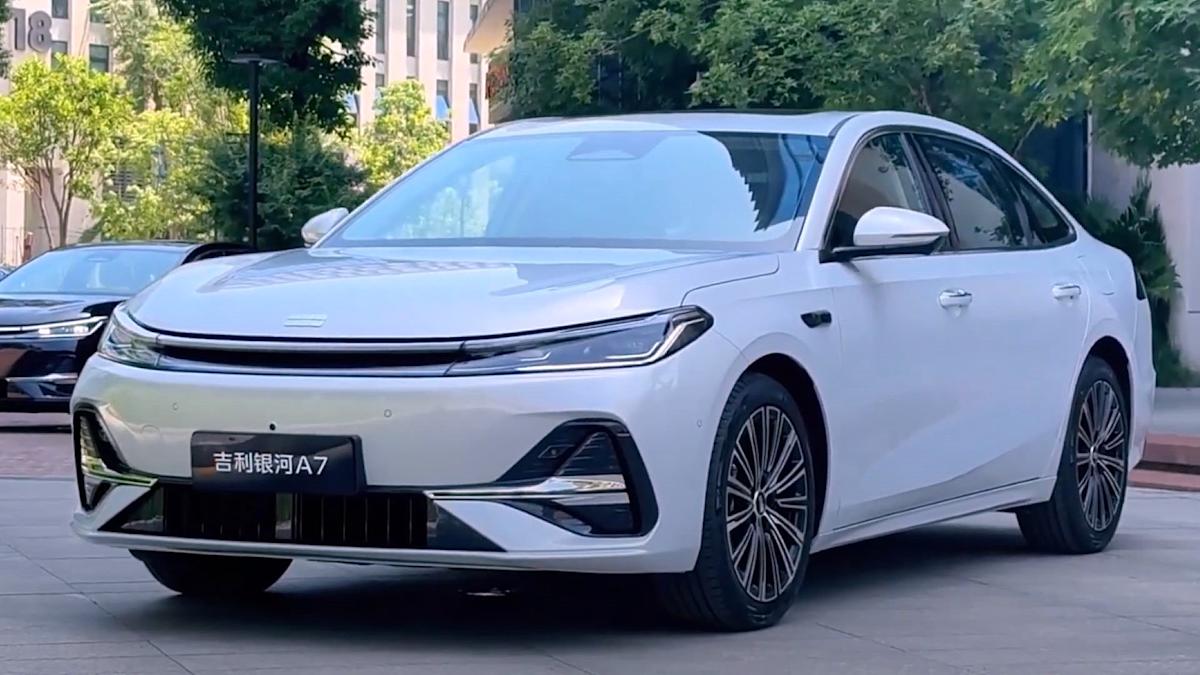Italy Electric Vehicle Market Overview
Market Size in 2024: USD 4.21 Billion
Market Size in 2033: USD 14.02 Billion
Market Growth Rate 2025-2033: 13.59%
According to IMARC Group’s latest research publication, “Italy Electric Vehicle Market Size, Share, Trends and Forecast by Component, Propulsion Type, Vehicle Type, and Region, 2025-2033”, The Italy electric vehicle market size was valued at USD 4.21 Billion in 2024. Looking forward, IMARC Group estimates the market to reach USD 14.02 Billion by 2033, exhibiting a CAGR of 13.59% during 2025-2033.
Download a sample PDF of this report: https://www.imarcgroup.com/italy-electric-vehicle-market/requestsample
Growth Factors in the Italy Electric Vehicle Market
● Government Incentives and EU Regulations
The electric vehicle (EV) market in Italy is buoyed by strong incentives from the government and strict EU regulations on carbon emissions. For example, the Italian government subsidies, such as the Ecobonus, can make purchasing an EV, like the Fiat 500e, considerably less expensive. Increased pressure from European regulations on vehicle CO2 emissions, has increased pressure on major OEM’s, suchs as Stellantis, to develop EV products from facilities, such as Mirafiori. Additionally, government tax incentives and low-emission zones in major cities, such as Milan provide further incentives to drive the transition to EV. All these incentives and levies have encouraged an incentive-based demand for electric vehicles and are stimulating the development of the EV segment. Overall, Italy transitional developments for EVs aligns with Europe’s green mobility ambitions moving forward.
● Expanding Charging Infrastructure
The advancement of EV charging infrastructure, both public and private, across Italy is an important driver of growth, solving the problem of range anxiety and boosting consumer confidence. Investment and rollout of charging networks is occurring at the public and private level across the country, with initiatives such as Enel X building fast-charging stations on highways and in city centers (e.g., Rome and Florence). Enel X’s JuicePump stations promote high-speed charging, as seen with the Tesla Model 3’s range and maximum charging capabilities. Additionally, with unique partnerships, such as charging points located in Coop supermarket locations, more users can access these charging networks. This developing network of charging installation promotes EV usage, advancing the market by providing more reliable options that are readily available and convenient.
● Increasing Consumer Awareness and Urbanization
Increasing environmental awareness and the urbanization of Italy’s population are catalysts for the EV market. Consumers in urbanized cities such as Turin and Bologna prefer to purchase electric vehicles (EVs) to travel within low-emission areas and have a lower carbon footprint. The Renault Zoe, for example, is popular with urban commuters because it is less bulky than a conventional vehicle and has environmental credibility. Public information campaigns and media coverage of climate change are also leading to increased interest in sustainable forms of transport. The significant increase in hybrid and EV sales in Italy reflects this change in attitudes. Wealthy consumers and businesses are purchasing hybrid and electric vehicles to help contribute to Italy’s sustainability goals which boosts demand.
Key Trends in the Italy Electric Vehicle Market
● Rise of Affordable Electric Models
The emergence of lower cost EV models is an important shift, allowing wider public access to electric mobility. Fiat has released the less expensive Fiat 500e, an affordable model competing with the Dacia Spring. In many ways the emergence of affordable models takes on the cost barrier for middle-class consumers in areas such as the Veneto region. The manufacturers are also leading the charge in terms of small electric vehicles, with their small size more practical given Italy’s often narrow streets. Dealers offering competitive financing and government incentives are also facilitating adoption. The shift toward low cost models increases the size of the EV market, enabling more Italians to move from an internal combustion engine vehicle to a new electric vehicle.
● Integration of Smart and Connected Technologies
Smart and connected technologies are driving compliance in the EV market, increasing user experience and functionality. EVs, such as the Volkswagen ID.3, featuring advanced infotainment systems with over-the-air updates are in strong demand among tech-savvy purchasers in vibrant cities such as Milan. Italian multinationals, such as Pininfarina, and the historical automotive industry are developing electric vehicles with integrated IoT systems, allowing for improvements in cooking and navigation by remote diagnostics of existing systems. Apps such as Enel X’s JuicePass that control charging, improve acquisition of fueling services by alunching the charge payment, finding chargers, and sharing points are improving UX. This upstream trend helps Italy achieve its digital innovation strategy and promote demand in smart, tech enabled EV’s better outlining and furthering a connected mobility ecosystem.
● Focus on Sustainable Manufacturing
EZ-EV production sustainability is getting more attention as manufacturers are increasingly prioritizing sustainable operational practice. For example, Stellantis has taken a green approach to manufacturing in terms of adopting more sustainable practices – using recycled materials to make car parts, and using green manufacturing principles at their plants in Turin to function and produce the Maserati GranTurismo Folgore. The EU’s Green Deal seeks to incentive carbon footprints reduction in production and is encouraging businesses to invest in creating renewable energy for operations and factory processes. In particular, Ferrari has invested in their Maranello facility where they use solar power even to produce EV assembly. The consumer pull is positive as people want to feel good about their vehicle purchase and Italy is becoming more committed to sustainability efforts; thus, it could boost the image and brand value of the industry, thus adding to their competitiveness and brand value in an increasingly commoditized market.
Buy Full Report: https://www.imarcgroup.com/checkout?id=23788&method=1130
Italy Electric Vehicle Industry Segmentation:
The report has segmented the market into the following categories:
Analysis by Component:
● Battery Cells and Packs
● Fuel Stack
● On-Board Charger
● Electric Motor
● Brake, Wheel and Suspension
● Body and Chassis
● Others
Analysis by Propulsion Type:
● Battery Electric Vehicle (BEV)
● Fuel Cell Electric Vehicle (FCEV)
● Plug-In Hybrid Electric Vehicle (PHEV)
Analysis by Vehicle Type:
● Passenger Vehicles
● Commercial Vehicles
● Others
Regional Analysis:
● Northwest
● Northeast
● Central
● South
● Others
Competitive Landscape:
The competitive landscape of the industry has also been examined along with the profiles of the key players.
Future Outlook
The Italy electric vehicle market is on the verge of rapid growth, as governments provide incentives, charging infrastructure continues to expand and consumer demand for sustainable transport increases. The European Union has set emissions regulations and Italy has publicly committed to achieving net zero, both of which will impact EV adoption in the long run. Both Fiat and Stellantis are developing electric transport lines as part of their expansion costs. New innovations around smart technology and lower cost models will make access to EV’s more feasible. Sustainable manufacturing in Italy will maintain Italy’s place in the long term in the European marketplace. Challenges, such as high costs and a lack of charging infrastructure for rural populations, will need to be addressed. With policy incentives and demand in urban populations, Italy could be a strong contributor to green mobility strategies in the region.
Ask Analyst for Sample Report: https://www.imarcgroup.com/request?type=report&id=23788&flag=C
Research Methodology:
The report employs a comprehensive research methodology, combining primary and secondary data sources to validate findings. It includes market assessments, surveys, expert opinions, and data triangulation techniques to ensure accuracy and reliability.
Note: If you require specific details, data, or insights that are not currently included in the scope of this report, we are happy to accommodate your request. As part of our customization service, we will gather and provide the additional information you need, tailored to your specific requirements. Please let us know your exact needs, and we will ensure the report is updated accordingly to meet your expectations.
About Us:
IMARC Group is a global management consulting firm that helps the world’s most ambitious changemakers to create a lasting impact. The company provide a comprehensive suite of market entry and expansion services. IMARC offerings include thorough market assessment, feasibility studies, company incorporation assistance, factory setup support, regulatory approvals and licensing navigation, branding, marketing and sales strategies, competitive landscape and benchmarking analyses, pricing and cost research, and procurement research.
Contact Us:
IMARC Group
134 N 4th St. Brooklyn, NY 11249, USA
Email: sales@imarcgroup.com
Tel No:(D) +91 120 433 0800
United States: +1-631-791-1145
This release was published on openPR.


